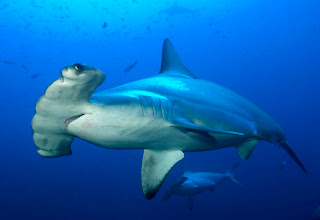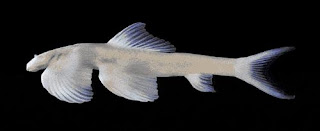Blogger no longer allows me to switch back to the "classic" version, so this is my first attempt at writing a blog entry with the new one, and anything could happen. I'll stick to the important info:
My latest feature is about the evolution of lichens. Recent findings suggest they are more recent than thought (which is disappointing from an astrobiology perspective as it means they didn't pioneer the vegetation on dry land), but their evolution was also more complex than thought, with the symbiotic link being made and broken and remade in some lineages, which called for the lovely title (which I nicked from the press release, and amazingly nobody else did that before me):
Lichenous liaisons
Current Biology Volume 30, Issue 18, 21 September 2020, Pages R1009-R1012
FREE access to full text and PDF download
Ophioparma, a lichen formed by a fungus and green algae, growing on rocks in the Alaskan tundra. The red spots are fungal fruiting bodies that release meiotically derived ascospores. (Photo: © Matthew P. Nelsen, Field Museum.)
Thursday, September 24, 2020
Monday, September 14, 2020
sharks in the open
Open Archive Day
There has been some exciting shark news in recent week at the biology front (eg about angel sharks or about giant sharks from the Cretaceous), but not so much in conservation issues, as the global slaughter carries on, so the hard work of raising awareness of shark conservation continues. My most recent feature about sharks and how they may end up on your dinner plate appeared a year ago, so it is now in the open archives:
Stop the global slaughter of sharks

The scalloped hammerhead (Sphyrna lewini) is one of the shark species whose fins were identified in a barcoding study of fish products in the UK. It also appears on the EDGE of Existence list of unique and endangered rays and sharks. (Photo: © Simon Rogerson.)
There has been some exciting shark news in recent week at the biology front (eg about angel sharks or about giant sharks from the Cretaceous), but not so much in conservation issues, as the global slaughter carries on, so the hard work of raising awareness of shark conservation continues. My most recent feature about sharks and how they may end up on your dinner plate appeared a year ago, so it is now in the open archives:
Stop the global slaughter of sharks

The scalloped hammerhead (Sphyrna lewini) is one of the shark species whose fins were identified in a barcoding study of fish products in the UK. It also appears on the EDGE of Existence list of unique and endangered rays and sharks. (Photo: © Simon Rogerson.)
Friday, September 11, 2020
science news 11.9.2020
Today's selection of science news. Links are normally to press releases on EurekAlert (at the bottom end I may also add a couple of newspaper stories). I include quotes from the summary in italics in cases where the title alone doesn't reveal what the story is about. My own thoughts appear without italics if I have any.
earth
66 million years of Earth's climate uncovered from ocean sediments
Understanding the 'deep-carbon cycle'
New geologic findings about the makeup of the Earth's mantle are helping scientists better understand long-term climate stability and even how seismic waves move through the planet's layers.
evolution
Coming up for air: Extinct sea scorpions could breathe out of water, fossil detective unveils
ecology
In the absence of otters, climate warming leads to Aleutian Reef decline
Sea otters prey on urchins and keep their population in check. When otters disappear, urchin populations explode, leading to overgrazing on kelp and a decline in kelp forests.
conservation
The surprising rhythms of Leopards: Females are early birds, males are nocturnal
After 10 months of camera surveillance in the Tanzanian rainforest, researchers from the University of Copenhagen have become the first to conclude that female and male leopards are active at very different times of the day. The discovery contradicts previous assumptions and could be used to help protect the endangered feline, whose populations have dwindled by 85 percent over the past century.
biomedical
Antibody responses in COVID-19 patients could guide vaccine design
The results show that the neutralizing activity of antibodies from recovered patients is typically not strong, and declines sharply within one month after hospital discharge.
environment
Multiphase buffering by ammonia explains wide range of atmospheric aerosol acidity
Anthropogenic ammonia emissions and the water content matter more than dry particle composition for the acidity of atmospheric aerosols in populated regions.
humans
Tel Aviv University study confirms widespread literacy in biblical-period kingdom of Judah
based on the identification of 12 different handwritings? I'm not sure I follow that conclusion. They could have rounded up the only 12 people in the kingdom who were able to write?

Examples of Hebrew ostraca from Arad.
Credit: Michael Cordonsky, TAU and the Israel Antiquities Authority
Addicted to the sun? Research shows it's in your genes
Sun-seeking behaviour is linked to genes involved in addiction, behavioural and personality traits and brain function, according to a study of more than 260,000 people led by King's College London researchers.
dystopian futures
Experiments reveal why human-like robots elicit uncanny feelings
---------------
From the news media:
earth
66 million years of Earth's climate uncovered from ocean sediments
Understanding the 'deep-carbon cycle'
New geologic findings about the makeup of the Earth's mantle are helping scientists better understand long-term climate stability and even how seismic waves move through the planet's layers.
evolution
Coming up for air: Extinct sea scorpions could breathe out of water, fossil detective unveils
ecology
In the absence of otters, climate warming leads to Aleutian Reef decline
Sea otters prey on urchins and keep their population in check. When otters disappear, urchin populations explode, leading to overgrazing on kelp and a decline in kelp forests.
conservation
The surprising rhythms of Leopards: Females are early birds, males are nocturnal
After 10 months of camera surveillance in the Tanzanian rainforest, researchers from the University of Copenhagen have become the first to conclude that female and male leopards are active at very different times of the day. The discovery contradicts previous assumptions and could be used to help protect the endangered feline, whose populations have dwindled by 85 percent over the past century.
biomedical
Antibody responses in COVID-19 patients could guide vaccine design
The results show that the neutralizing activity of antibodies from recovered patients is typically not strong, and declines sharply within one month after hospital discharge.
environment
Multiphase buffering by ammonia explains wide range of atmospheric aerosol acidity
Anthropogenic ammonia emissions and the water content matter more than dry particle composition for the acidity of atmospheric aerosols in populated regions.
humans
Tel Aviv University study confirms widespread literacy in biblical-period kingdom of Judah
based on the identification of 12 different handwritings? I'm not sure I follow that conclusion. They could have rounded up the only 12 people in the kingdom who were able to write?

Examples of Hebrew ostraca from Arad.
Credit: Michael Cordonsky, TAU and the Israel Antiquities Authority
Addicted to the sun? Research shows it's in your genes
Sun-seeking behaviour is linked to genes involved in addiction, behavioural and personality traits and brain function, according to a study of more than 260,000 people led by King's College London researchers.
dystopian futures
Experiments reveal why human-like robots elicit uncanny feelings
---------------
From the news media:
Thursday, September 10, 2020
science news 10.9.2020
Today's selection of science news. Links are normally to press releases on EurekAlert (at the bottom end I may also add a couple of newspaper stories). I include quotes from the summary in italics in cases where the title alone doesn't reveal what the story is about. My own thoughts appear without italics if I have any.
astrobiology
Where rocks come alive: NASA's OSIRIS-REx observes an asteroid in action
In Ancient Giant Viruses Lies the Truth Behind Evolution of Nucleus in Eukaryotic Cells
An exchange of genetic material that occurred when ancient giant viruses infected ancient eukaryotic cells could have caused the nucleus of the eukaryotic cell--its defining feature--to form. This is what Professor Masaharu Takemura of the Tokyo University of Science, Japan, suggests in his recent review in the journal Frontiers in Microbiology. His novel evolutionary hypothesis opens doors to new discussions on the subject, bringing us one giant step closer to the truth.
earth
New insight on the impacts of Earth's biosphere on air quality
specifically, this is about the distribution of isoprene in the atmosphere.
conservation
At least 28 extinctions prevented by conservation action in recent decades
New tracking technology will help fight rhino poaching in Namibia
Interactive software that 'reads' and analyzes footprints left by black rhinoceroses can be used to monitor the movements of the animals in the wild, giving conservationists a new way to keep watch on the endangered species and help keep it safe from poachers, according to a Duke University-led study.

A black rhino and its calf; new technology that uses software to read unique features of rhino footprints will help protect this endangered species from poachers.
Credit: WildTrack
nanoworld
A chemist from RUDN developed a new type of one-molecule thick water-repellent film
... out of calixarenes, to be specific.
biomedical
More cats might be COVID-19 positive than first believed, study suggests
sustainability
Do as plants do: Novel photocatalysts can perform solar-driven conversion of CO2 into fuel
---------------
From the news media:
astrobiology
Where rocks come alive: NASA's OSIRIS-REx observes an asteroid in action
In Ancient Giant Viruses Lies the Truth Behind Evolution of Nucleus in Eukaryotic Cells
An exchange of genetic material that occurred when ancient giant viruses infected ancient eukaryotic cells could have caused the nucleus of the eukaryotic cell--its defining feature--to form. This is what Professor Masaharu Takemura of the Tokyo University of Science, Japan, suggests in his recent review in the journal Frontiers in Microbiology. His novel evolutionary hypothesis opens doors to new discussions on the subject, bringing us one giant step closer to the truth.
earth
New insight on the impacts of Earth's biosphere on air quality
specifically, this is about the distribution of isoprene in the atmosphere.
conservation
At least 28 extinctions prevented by conservation action in recent decades
New tracking technology will help fight rhino poaching in Namibia
Interactive software that 'reads' and analyzes footprints left by black rhinoceroses can be used to monitor the movements of the animals in the wild, giving conservationists a new way to keep watch on the endangered species and help keep it safe from poachers, according to a Duke University-led study.

A black rhino and its calf; new technology that uses software to read unique features of rhino footprints will help protect this endangered species from poachers.
Credit: WildTrack
nanoworld
A chemist from RUDN developed a new type of one-molecule thick water-repellent film
... out of calixarenes, to be specific.
biomedical
More cats might be COVID-19 positive than first believed, study suggests
sustainability
Do as plants do: Novel photocatalysts can perform solar-driven conversion of CO2 into fuel
---------------
From the news media:
Wednesday, September 09, 2020
science news 9.9.2020
Today's selection of science news. Links are normally to press releases on EurekAlert (at the bottom end I may also add a couple of newspaper stories). I include quotes from the summary in italics in cases where the title alone doesn't reveal what the story is about. My own thoughts appear without italics if I have any.
earth
Deep channels link ocean to Antarctic glacier
meaning warm water can lick it away
evolution
New fossil ape is discovered in India
A 13-million-year-old fossil unearthed in northern India comes from a newly discovered ape, the earliest known ancestor of the modern-day gibbon. The discovery fills a major void in the ape fossil record and provides important new evidence about when the ancestors of today's gibbon migrated to Asia from Africa.
Skeletal study suggests at least 11 fish species are capable of walking
See also my feature on evolution of lineages gaining or losing their legs

Thailand's cave angel fish, Cryptotora thamicola, is famous for its ability to walk, using a salamander-like gait. But it may not be alone: At least 10 relatives share its unusual pelvic shape.
Credit: Zachary Randall/Florida Museum
ecology
International study gets at the root of what makes deer migrate
Researchers found that the dynamics of springtime plant growth, specifically whether green-up progresses like a wave or not, explain where deer migration occurs in many ecosystems.
Gulls pay attention to human eyes
Herring gulls notice where approaching humans are looking, and flee sooner when they're being watched, a new study shows.
For a moment I thought the gulls were checking if you're watching your food ...
conservation
Lost frogs rediscovered with environmental DNA
Scientists have detected signs of a frog listed extinct and not seen since 1968, using an innovative technique to locate declining and missing species in two regions of Brazil.
biomedical
High-intensity focused ultrasound _treatment_ for prostate cancer: First US study shows promising outcomes
The title originally didn't make it clear, but this is a new method of treating the cancer, instead of radiation or chemotherapy. It's not about diagnostic ultrasound.
Recharging N95 masks for continued usage
N95 masks achieve 95% efficiency at filtering out 0.3-micron particles, while maintaining reasonable breathability, thanks to a layer of polypropylene fibers incorporating electrical charges to attract particles. Extended usage and decontamination, provoked by severe shortages during the pandemic, can easily remove the charges and degrade filtration efficiency. In Physics of Fluids, researchers share a method to restore the filtration efficiency of N95 masks to out-of-box levels, as long as the mask is not structurally compromised.
Could singing spread COVID-19?
wear a mask, skip the consonants
humans
The oldest Neanderthal DNA of Central-Eastern Europe
A new study reports the oldest mitochondrial genome of a Neanderthal from Central-Eastern Europe. The mitochondrial genome of the tooth, discovered at the site of Stajnia Cave in Poland, is closer to a Neanderthal specimen from the Caucasus than to the contemporaneous Neanderthals of Western Europe. Stone tools found at the site are also analogous to the southern regions suggesting that Neanderthals living in the steppe/taiga environment had a broader foraging radius than previously envisaged.
Ancient hunters stayed in frozen Northern Europe rather than migrating to warmer areas, evidence from Arctic fox bones shows
---------------
From the news media:
Oxford Covid vaccine trial on hold after adverse reaction in one participant.
earth
Deep channels link ocean to Antarctic glacier
meaning warm water can lick it away
evolution
New fossil ape is discovered in India
A 13-million-year-old fossil unearthed in northern India comes from a newly discovered ape, the earliest known ancestor of the modern-day gibbon. The discovery fills a major void in the ape fossil record and provides important new evidence about when the ancestors of today's gibbon migrated to Asia from Africa.
Skeletal study suggests at least 11 fish species are capable of walking
See also my feature on evolution of lineages gaining or losing their legs

Thailand's cave angel fish, Cryptotora thamicola, is famous for its ability to walk, using a salamander-like gait. But it may not be alone: At least 10 relatives share its unusual pelvic shape.
Credit: Zachary Randall/Florida Museum
ecology
International study gets at the root of what makes deer migrate
Researchers found that the dynamics of springtime plant growth, specifically whether green-up progresses like a wave or not, explain where deer migration occurs in many ecosystems.
Gulls pay attention to human eyes
Herring gulls notice where approaching humans are looking, and flee sooner when they're being watched, a new study shows.
For a moment I thought the gulls were checking if you're watching your food ...
conservation
Lost frogs rediscovered with environmental DNA
Scientists have detected signs of a frog listed extinct and not seen since 1968, using an innovative technique to locate declining and missing species in two regions of Brazil.
biomedical
High-intensity focused ultrasound _treatment_ for prostate cancer: First US study shows promising outcomes
The title originally didn't make it clear, but this is a new method of treating the cancer, instead of radiation or chemotherapy. It's not about diagnostic ultrasound.
Recharging N95 masks for continued usage
N95 masks achieve 95% efficiency at filtering out 0.3-micron particles, while maintaining reasonable breathability, thanks to a layer of polypropylene fibers incorporating electrical charges to attract particles. Extended usage and decontamination, provoked by severe shortages during the pandemic, can easily remove the charges and degrade filtration efficiency. In Physics of Fluids, researchers share a method to restore the filtration efficiency of N95 masks to out-of-box levels, as long as the mask is not structurally compromised.
Could singing spread COVID-19?
wear a mask, skip the consonants
humans
The oldest Neanderthal DNA of Central-Eastern Europe
A new study reports the oldest mitochondrial genome of a Neanderthal from Central-Eastern Europe. The mitochondrial genome of the tooth, discovered at the site of Stajnia Cave in Poland, is closer to a Neanderthal specimen from the Caucasus than to the contemporaneous Neanderthals of Western Europe. Stone tools found at the site are also analogous to the southern regions suggesting that Neanderthals living in the steppe/taiga environment had a broader foraging radius than previously envisaged.
Ancient hunters stayed in frozen Northern Europe rather than migrating to warmer areas, evidence from Arctic fox bones shows
---------------
From the news media:
Oxford Covid vaccine trial on hold after adverse reaction in one participant.
Tuesday, September 08, 2020
science news 8.9.2020
Today's selection of science news. Links are normally to press releases on EurekAlert (at the bottom end I may also add a couple of newspaper stories). I include quotes from the summary in italics in cases where the title alone doesn't reveal what the story is about. My own thoughts appear without italics if I have any.
Not much going on today, apparently:
evolution
Ancient bony fish forces rethink of how sharks evolved
nanoworld
A new twist on DNA origami
sustainability
Producing leather-like materials from fungi
humans
'Wild West' mentality lingers in modern populations of US mountain regions
Scientists looked at links between the personality profiles of over 3.3m US residents and the "topography" of 37,227 ZIP codes. Distinct psychological mix associated with mountain populations is consistent with theory that harsh frontiers attracted certain personalities. Researchers argue this may be residual from US frontier expansion during the 19th century, as personality pattern is strongest in the West.
---------------
From the news media:
the biggest bang since the Big Bang
and an essay written by a robot. Scary stuff.
Not much going on today, apparently:
evolution
Ancient bony fish forces rethink of how sharks evolved
nanoworld
A new twist on DNA origami
sustainability
Producing leather-like materials from fungi
humans
'Wild West' mentality lingers in modern populations of US mountain regions
Scientists looked at links between the personality profiles of over 3.3m US residents and the "topography" of 37,227 ZIP codes. Distinct psychological mix associated with mountain populations is consistent with theory that harsh frontiers attracted certain personalities. Researchers argue this may be residual from US frontier expansion during the 19th century, as personality pattern is strongest in the West.
---------------
From the news media:
the biggest bang since the Big Bang
and an essay written by a robot. Scary stuff.
Monday, September 07, 2020
value your vultures
Vultures are still suffering from image problems in many cultures, due to their association with death and decay. We should really appreciate them a lot more, however, as their removal of carcasses is an extremely important and valuable ecosystem service. India has lost large parts of its vulture population in recent decades and is already feeling the consequences which include opportunistic mammalian scavengers such as rats and feral dogs spreading diseases that also affect humans, such rabies and the plague. And now Africa is at risk of a similar decline in vulture populations, which could have even worse effects there.
In my latest feature I have looked at the causes and effects of vulture declines around the world, and also marvelled at the different cultural associations we have with various species. The Andean condor, for instance, is also a vulture but doesn't appear to have the same image problem as the other species.
The feature is out now:
Hard times for ecosystem cleaners
Current Biology Volume 30, Issue 17, 7 September 2020, Pages R963-R966
FREE access to full text and PDF download

Vultures are having a hard time in the Lucky Luke comics, too - targeted by jokes if not by bullets ...
If reading the feature is too much work, there is a video about vulture conservation here.
In my latest feature I have looked at the causes and effects of vulture declines around the world, and also marvelled at the different cultural associations we have with various species. The Andean condor, for instance, is also a vulture but doesn't appear to have the same image problem as the other species.
The feature is out now:
Hard times for ecosystem cleaners
Current Biology Volume 30, Issue 17, 7 September 2020, Pages R963-R966
FREE access to full text and PDF download

Vultures are having a hard time in the Lucky Luke comics, too - targeted by jokes if not by bullets ...
If reading the feature is too much work, there is a video about vulture conservation here.
Labels:
birds,
conservation,
currentbiology,
ecology,
LA_ciencia,
sciencejournalism
Subscribe to:
Posts (Atom)














